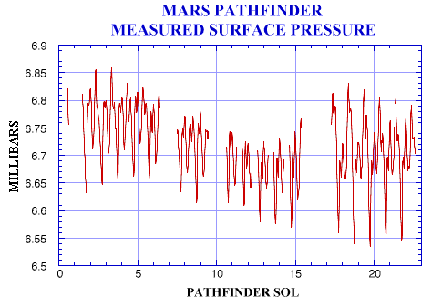

Surface Pressure from Pathfinder
Surface Pressure Changes: The diagram shows Surface pressure, in units of millibars, measured by the Pathfinder lander on the Martian surface. Changes in measured pressure during a day are caused by the warming/expansion of the atmosphere which follows the sun around the planet and the cooling/contraction which follows the night. Similar atmospheric processes occur on Earth. The interpretation of the observed variation indicates the presence of suspended dust over a large portion of the planet and mixed upwards to several tens of kilometers in depth.

Wind
Wind: The diagram above was obtained from Sagan Memorial Station: Wind direction at the Mars Pathfinder site is indicated as the direction from which the wind is coming: i.e. a southerly wind is a wind from the south. During the initial sols of the mission, wind direction rotated in a clockwise manner with time: southerly at night, westerly in the morning, northerly during early afternoon, and from the east in the evening. Winds from the south at night are consistent with flow down the Ares Valley at whose northern end Pathfinder is located.

Temperature
Temperature: A key debate in the Martian atmospheric sciences community has been over whether Martian climate has changed significantly since the era of the Viking missions. The issue has been whether the lower and middle atmosphere of Mars (altitudes less than 50 km) are "cold" relative to Viking or whether they are "warm" as at the time of Viking. The temperature profile in this figure above shows the upper atmosphere of Mars to be quite cold relative to Viking. In fact at about 80 km altitude, the temperature is the lowest ever measured on Mars; -275 degrees Fahrenheit. The cold temperatures in this region of the atmosphere are not surprising since Mars Pathfinder entered the atmosphere at 3 AM Mars Local Time when the upper atmosphere cools due to the lack of solar heating. Below 60 km altitude, the temperatures measured by Pathfinder are quite close to those measured by Viking. Therefore, the measurements by Mars Pathfinder, which represent one slice through the atmosphere at one location and time, show that the atmosphere is as "warm" as it was at the time of Viking.